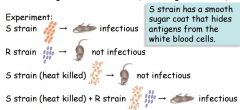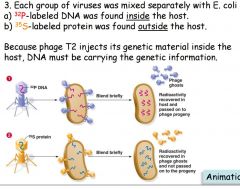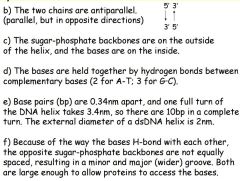![]()
![]()
![]()
Use LEFT and RIGHT arrow keys to navigate between flashcards;
Use UP and DOWN arrow keys to flip the card;
H to show hint;
A reads text to speech;
23 Cards in this Set
- Front
- Back
|
Griffith's Transformation Experiment (1928) purpose |
experiment with Streptococcus pneumonia bacteria in mice showed that genetic material passed from dead bacteria into nearby living ones, allowing them to change their cell surface |
|
|
Griffith's transformation experiment |

The R bacteria uptake some genetic material (that are required for making the sugar coat that hides the antigens) from the dead S bacteria, and are transformed into an infectious strain |
|
|
Griffith's transformation experiment results |
experiment that resulted in calling the unknown genetic material the "transforming principle" |
|
|
Avery's Transformation Experiments (1944) |
Aimed to determine the identity of the transforming principle: Lysed dead S cells, separated cell extract, determined with component of the extract is capable of transforming an R strain into an S strain. When DNase was added, there was no transformation --> transforming principle is DNA |
|
|
Hershey-Chase Bacteriophage Experiments (1953) |
more evidence for DNA as the genetic material from research on bacteriophage of T2 |
|
|
Hershey-Chase experiment methods |

T2 DNA labeled with 32P T2 proteins labeled with 35S |
|
|
Hershey-Chase experiment results |
32P labeled DNA was found inside host --> because phage injects its genetic material inside the host, DNA must be carrying the genetic information The transferring principle was found to be the cellular material that could alter a cell's heritable characteristics |
|
|
Each nucleotide (monomers that make up DNA and RNA) has 3 parts: |
pentose sugar (5-carbon), nitrogenous base, phosphate group |
|
|
Purines |
Class of nitrogenous bases that are double-ring, nine-membered structures: A & G |
|
|
Pyrimidines |
Class of nitrogenous bases that are one-ring, six-membered structures: C & T, U |
|
|
Nucleoside |
the sugar-base combo - when a phosphate is added, it becomes a nucleotide |
|
|
What creates the backbone of a nucleic acid molecule? |
The phosphate groups on the 5'C of one nucleotide and the 3'C of another, held together by asymmetric phosphodiester bonds (stable covalent bonds) |
|
|
What is the 5'-3' polarity created by within the nucleic acid chain? |
Asymmetry of phospodiester bonds |
|
|
Erwin Chargoff's experiment |
G=C, A=T --> suggests base pairing also, but he didn't realize it |
|
|
Franklin and Wilkins experiment |
X-ray diffraction images of DNA showed a helical structure 0.34 nm - length between base pairs 3.4 nm - 1 helical turn |
|
|
Watson and Crick's model |

DNA has 2 poylnucleotide chains, that run antiparallel, wound around each other in a right-handed (clockwise) double helix |
|
|
Internal base pairing and RNA |
RNA is single stranded, but internal base pairing can produce secondary structure in the molecule (tRNA) |
|
|
The nucleic acid of a virus may be |
dsDNA, ssDNA, dsRNA, or SSRNA; linear or circular; single molecule or several segments |
|
|
Chromatin |
DNA-protein complex that constitutes chromosomes (only in eukaryotes) |
|
|
Nucleosome |
Basic unit of chromatin |
|
|
Euchromatin |
usually (transcriptionally) active (lightly packed), most of genome |
|
|
Heterochromatin |
usually inactive (tightly packed) e.g. centromeres and telomeres (repeat sequences at chromosome end) At the ends and middle of the chromosome |
|
|
Histone |
compact DNA, enable/regulate gene expression |

